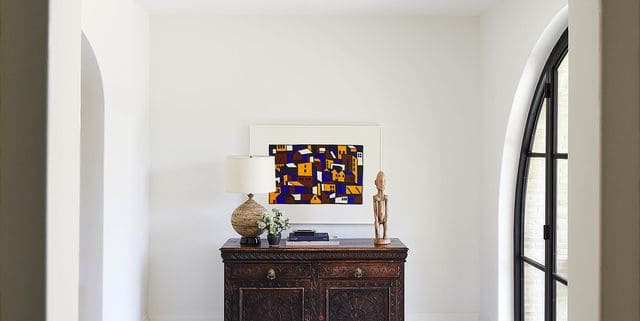Creating an elegant and timeless interior requires a keen eye for detail and an appreciation for classic design elements. One such design choice that has withstood the test of time is the combination of alabaster walls with pure white trim. This pairing not only exudes sophistication but also provides a versatile backdrop for various decor styles. In this comprehensive guide, we will explore the allure of alabaster walls, the benefits of pure white trim, and how this combination can transform any space into a haven of elegance.
The Timeless Beauty of Alabaster Walls
Alabaster, a soft and luminous shade of white, has long been a favorite in interior design. Its subtle warmth and depth set it apart from stark whites, making it a perfect choice for walls. Here’s why alabaster walls are a timeless choice:
Subtle Elegance and Warmth
Alabaster walls exude a subtle elegance that stark white walls often lack. The warm undertones of alabaster create a welcoming and cozy atmosphere, making any room feel more inviting. This quality makes it an ideal choice for both modern and traditional interiors.
Versatility in Design
One of the greatest advantages of alabaster walls is their versatility. They serve as a neutral backdrop that complements a wide range of colors and textures. Whether you prefer a minimalist aesthetic or a more eclectic style, alabaster walls provide the perfect canvas for your creative expression.
Enhancing Natural Light
Alabaster walls have a unique ability to enhance natural light. The soft, reflective quality of the color brightens up spaces, making them appear larger and more open. This is particularly beneficial for rooms with limited natural light, as it maximizes the available light and creates a more airy ambiance.
The Crisp Perfection of Pure White Trim
While alabaster walls bring warmth and depth to a room, pure white trim adds a crisp and clean contrast. The combination of these two elements creates a harmonious balance that elevates the overall aesthetic of any space.
Creating Visual Interest
Pure white trim acts as a striking accent against alabaster walls, drawing attention to architectural details such as crown molding, baseboards, and window frames. This contrast not only adds visual interest but also highlights the craftsmanship of these elements.
Defining Spaces
In open-concept layouts, pure white trim can be used to define different areas within the same space. By outlining doorways, windows, and built-in features, the trim creates distinct boundaries while maintaining a cohesive look throughout the room.
Timeless Appeal
The combination of pure white trim with alabaster walls is a classic choice that never goes out of style. This pairing is adaptable to various design trends, ensuring that your interior remains elegant and relevant for years to come.
Incorporating Alabaster Walls and Pure White Trim into Your Home
To successfully incorporate alabaster walls and pure white trim into your home, it’s important to consider the overall design scheme and the specific characteristics of each room. Here are some tips to help you achieve a seamless and sophisticated look:
Choosing the Right Alabaster Shade
Not all alabaster shades are created equal. Some may lean towards cooler tones, while others have warmer undertones. It’s essential to select an alabaster shade that complements the existing elements in your space. Test a few samples on your walls to see how they interact with natural and artificial light throughout the day.
Pairing with Complementary Colors
While alabaster walls and pure white trim are a stunning combination on their own, adding complementary colors can enhance the overall design. Soft pastels, muted earth tones, and bold jewel tones all work beautifully with alabaster and white. Consider incorporating these colors through furniture, textiles, and accessories.
Balancing Textures and Materials
To prevent a monochromatic scheme from feeling flat, balance the textures and materials in your space. Incorporate a mix of smooth and textured finishes, such as silk curtains, linen upholstery, and natural wood accents. This variety adds depth and dimension to the room, creating a more dynamic and engaging environment.
Highlighting Architectural Features
Take advantage of pure white trim to highlight architectural features in your home. Intricate crown molding, elegant wainscoting, and detailed window frames all benefit from the crisp definition that white trim provides. These elements become focal points, adding character and sophistication to your interior.
Maintaining the Look
Keeping your alabaster walls and pure white trim looking pristine requires regular maintenance. Here are some tips to ensure your space remains elegant and fresh:
Regular Cleaning
Dust and dirt can accumulate on walls and trim over time. Regularly dusting and gently cleaning these surfaces with a soft cloth and mild detergent will help maintain their appearance. Avoid using harsh chemicals that can damage the paint finish.
Touch-Up Paint
Inevitable wear and tear can lead to small chips and scratches on your walls and trim. Keep a small amount of touch-up paint on hand to address these imperfections as they arise. Promptly fixing minor damage prevents it from becoming a larger issue and keeps your space looking immaculate.
Protecting from UV Damage
Prolonged exposure to sunlight can cause paint colors to fade over time. Protect your alabaster walls and white trim by using window treatments such as curtains or blinds to control the amount of natural light entering the room. UV-protective window films are also an effective solution.
Conclusion
The combination of alabaster walls with pure white trim is a timeless choice that brings elegance and sophistication to any interior. This classic pairing enhances natural light, adds visual interest, and provides a versatile backdrop for various decor styles. By carefully selecting complementary colors, balancing textures, and maintaining the pristine appearance of your walls and trim, you can create a space that exudes timeless beauty and charm.


